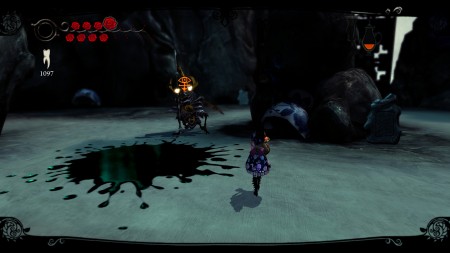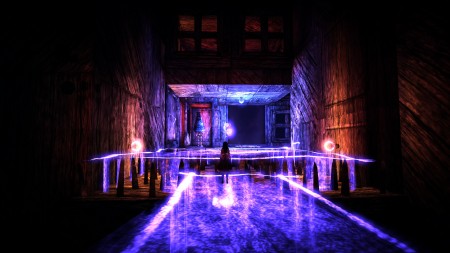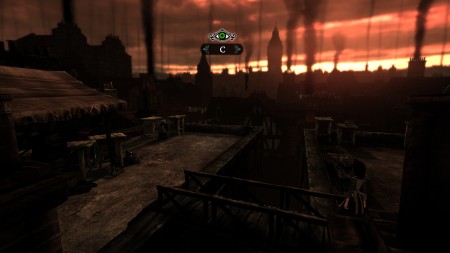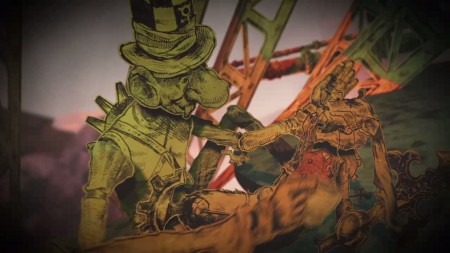Alice: Madness Returns – The Verdict
A month ago, I went at American McGee’s Alice with a rather snicker-snack attitude, penning a retrospective though I’d neither played the game before, nor particularly enjoyed it as I played it. Whilst ageing mechanics had a lot to do with it, I was perhaps most put out by the decade or so I’d spent assuming it was a great game wrapped around a fantastic concept. So with Alice: Madness Returns, I’ve decided to take the same prejudicial route, noting the lacking hype and lukewarm scores. And yes, I’ve disappointed myself again. Because it’s not quite as mediocre as some are saying it is.
It’s only to be expected that Alice the game has matured a lot in a decade. The Quake pedigree has been excised in favour of a modern third-person shooter / brawler style, and it’s a more than competent refinement: Alice now dodges attacks (turning into a swarm of fetching butterflies, no less), and though you can theoretically play the entire game by manually aiming, locking onto enemies is just so much easier.
Your extended arsenal comes to include two melee and two ranged weapons, remotely detonable rabbits, a ‘berserk on demand’ ability that you can trigger when on the edge of death and a rather awesome looking parasol that deflects and defends. Built around gamepad controls (but not deficient with mouse and keyboard), these abilities are always within reach during the frantic combat (which wisely goes into slow-motion when an enemy is going to do a massive attack), and though the length of the game tests the same skills far too much, it does a fantastic job of making you mix and match approaches. Meanwhile, teeth dropped by enemies are upgrade currency for the four main weapons, meaning that though the reuse of enemies is over-rampant, you at least cut through them more easily as you progress. Sometimes it seems that the game is attempting to create difficulty by confounding the lock-on system with re-spawning small fry in what’s supposed to be a large boss encounter, but ultimately, the combat is fundamentally and deeply satisfying.
Strangely enough, the one game that Alice now resembles most is Psychonauts, an inspiration that is at once noble, brave and rather foolhardy. It’s a rather fruitful and obvious place for comparison, really. They’re both games about exploring psychic planes and Psychonauts took the lion’s share of its inspirations from Lewis Carrol’s tales in the first place. At length you find Alice equally tolerable as a platformer – like Psychonauts, it’s very reliant on double jumps, floating and abilities that open secret packages – but the platforming in both games sometimes feels as superfluous as it is ubiquitous. You may not fall to your death every five seconds, but you’ll start to curse the appearance of yet another jumping section.
Alice: Madness Returns actually thanks Tim Schafer in its credit reel, but it doesn’t quite have enough of what made his most famously obscure title an enduring classic. It’s tempting to pass over Alice as an ‘unfunny Psychonauts‘, but this would be unfair. Firstly because Psychonauts is one of three games that I’ve played that are genuinely funny (and its two lead writers separately made the other two). But more importantly, Alice is supposed to have a different mix of the sinister and the laugh-worthy. It shoots and misses multiple times (the writing is still a shadow of the original work, but what isn’t?) but it feels consistent and it’s definitely the right tone for the story that is being told.
The problem lies more in the lack of variety in, and the variable quality of the narrative. The two are intertwined in a way that helps amplify an already humdrum and overlong series of levels. Taken individually, the game’s five main chapters have a sort of ‘Director’s Cut’ quality about them: even despite each chapter mixing things up with at least one passable mini-game, there ‘s always one fetch-quest too many, and a handful of enemy encounters that you could have done without. You can see the finer points and the better ideas in there, so it’s tolerable. But as you progress, a weak unifying narrative thread starts to drag the game under and it becomes a rather meandering experience.
It’s not even an uncommon problem for adaptations of Alice in Wonderland (just look at the Disney version). Alice adaptations have largely been about following white rabbits from event to event ultimately to reach whichever scene you judge to be the most climatic, drawing up an itinerary of classic Alice characters and environments as you go. The thing is, Alice Madness Returns isn’t an adaptation. It’s supposed to be a sequel to a re-imagined sequel, so why are we still engaging in all this tedious checklisting?
This is the place in which the game feels most like a throwback. a procession of texture packs, enemy types, bosses and characters, rather than a cohesive whole – even the Cheshire cat will only phone it in if you specifically request his presence. In place of more consistent face time with the classic characters is an overarching plot in which Alice talks to various one-shot figures in her life with the ever vague intention of sorting out her mental state. The charming caricature of Victorian London in which this takes place could have been a perfect hub-world of access points to wonderland’s various domains, but instead plays out as yet another linear corridor between seemingly unrelated encounters.
Of course, with only five incredibly drawn out chapters (and a token climatic scene), a hub world would have been unnecessary, but that’s my point. Alice: Madness Returns could have legitimately been as long as it is if it featured smaller worlds, featured more of them, and kept its cast along for the ride so we could grow to have any involvement with them whatsoever.
As it happens, the seemingly disparate story comes together for an endgame reveal that, whilst hardly astonishing, makes for a satisfying conclusion. Not to say it excuses the preceding twelve hours of direction-less buck passing, but considering how visually well such a mundane story is told, it’s easy to look back on the whole and conclude that, actually, it was rather enjoyable. The main points are told through FMVs featuring wood-cut styled characters and environments with intentionally limited animation, but a dimensionality that suggests they’ve ‘leapt from the page’. They’re absolutely gorgeous and they in no way break immersion in a game that is – superficially at least – uniformly beautiful. Even as the platforming frustrates and you wish each and every sequence had ended at least thirty minutes ago, you look around and still feel a little wowed by it all.
Oh, there’s still a little too much brown in there at times (especially in the first chapter) and the characters still have an odd, ‘deformed to be different’ look to them that represents a taste you have to acquire, but there’s some fabulous little details. I can be a bit of a prejudicial reviewer, and I tend to think up oh-so-snarky lines before I’ve even played the game to ease the strain of trying to appear intelligent. For Alice: Madness Returns, that line was something approximating ‘sure, it looks pretty, but why not just buy the artbook‘, and I quickly came to regret having supposed I could use that. In motion it’s as complete a vision of Wonderland as has ever been conceptualised.
There’s one word that keeps nagging at me to be said in reference to this game: it’s ‘sincere’. The list of faults nags at you as you play, and it will cause many to simply give up and play something more worthy. But that list of faults results from good intentions and a genuine passion for a literary classic; I know I won’t be the only one that ticks boxes for. For those who stick it out to the end, I’m sure you’ll agree that the only real problem here is the nagging sense of under-achievement, because the parts that make this product a ‘game’ are so rarely exceptional. But you’ll also see that there’s more than a spark of something incredible here when taking it merely as ‘an experience’.
Verdict: On Target
Platforms Available – PC, PS3, 360
Platform Reviewed – PC



